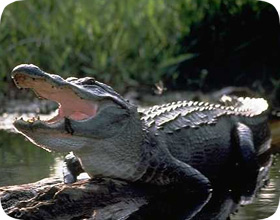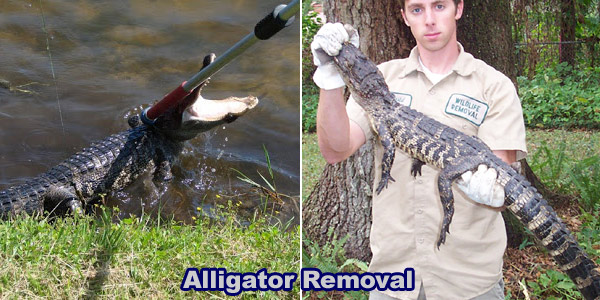-
info@aaanimalcontrol.com
Call us for help in your town
Humane Wildlife Education
Facts and Information about the Orlandoo Alligator
Need alligator removal in your hometown? We service over 500 USA locations! Click here to hire us in your town and check prices - updated for year 2020.
Alligators are plentiful in central Florida, including the Orlando area. This includes not just the outskirts, but right in the center of the city! Virtually any body of water can hold alligators. Most Orlando
lakes are connected by channels or pipes. Alligators can also travel across land, of course.
Many Orlando residents are fearful of alligators, but they're not really of any concern until they start to get to 7 feet or above, which is admittedly a rare size in urban and suburban areas. Gators of this size
do show up occasionally though, so if you see one, call the Florida Wildlife Commission.
 The Florida alligator is a reptile that has the appearance of a crocodile. It has an armored lizard-like body, powerful jaws and a muscular tail. According to scientists, this species is more than a hundred and fifty million years old. The American alligator usually resides close to freshwater lakes, rivers, marshes and swamps of the southeastern region of the U.S.A particularly in Louisiana and Florida. There are over one million alligators in each of these two states. They also live in the southern parts of Alabama, Mississippi and Georgia as well as Eastern Texas, southern Arkansas and southeastern Oklahoma.
The Florida alligator is a reptile that has the appearance of a crocodile. It has an armored lizard-like body, powerful jaws and a muscular tail. According to scientists, this species is more than a hundred and fifty million years old. The American alligator usually resides close to freshwater lakes, rivers, marshes and swamps of the southeastern region of the U.S.A particularly in Louisiana and Florida. There are over one million alligators in each of these two states. They also live in the southern parts of Alabama, Mississippi and Georgia as well as Eastern Texas, southern Arkansas and southeastern Oklahoma.
The adult alligator is an apex predator that plays a great role in the biodiversity of its habitat. It feeds mainly on snakes, fish, small mammals and turtles. However, this species is an opportunist and when hungry, an alligator can eat anything including pets, carrion and humans in rare instances. One common method that this species uses to kill larger prey is to grab it and drag it into the water to cause drowning. If a gator catches prey that it cannot eat in one bite, it allows it to rot or eats it by biting and then convulsing or spinning wildly until it tears off bite size chunks.
An adult alligator weighs 360 kilograms (800lb) and is 4.0 meters (13ft) long. However, it can grow to 4.4 meters (14.5 feet) long and weigh more than 450 kgs (1000 lb). The largest gator discovered was found in Louisiana. It had a length of 5.84 meters (19 ft, 2inches). On average gators have seventy five teeth.
Alligators have a very long lifespan even though their average lifespan has not been recorded. A one year old alligator that was taken from Germany to the Belgrade Zoo in Serbia in 1937 is now 76 years old. Large male alligators are territorial solitary animals. Smaller alligators on the other hand live close together in large numbers. The largest alligators defend their prime territory regardless of whether they are males or females but smaller alligators tolerate other alligators that are similar in size to them. Even though the alligator has a heavy body and a slow metabolism, it is able run fast for short distances. This reptile is generally timid when approached by humans.
In the summer season, the female alligator builds a nest using vegetation. Decomposing matter in the vegetation becomes the source of heat necessary for egg incubation. The nest’s temperature determines the offspring’s sex and it is usually fixed within seven to twenty one days of the beginning of incubation. If the incubation temperatures are 86 degrees F (30 degrees C) or lower, the offspring will be female. Temperatures higher than 93 degrees F (34 degrees C) or higher will produce male offspring.
The nests that the gator constructs on leaves achieve higher temperatures than that it constructs on wet marsh. For this reason, the former nests tend to produce males while the latter nests produce females. The female alligator ensures that predators do not come near the nest and assists the hatchlings to get to water. She offers protection the young for a year if they reside in the area where they hatched. Adult alligators are the largest threat to the hatchlings as they predate on them. The alligator is the only non-avian species that has one-way breathing.
Read more about alligator trapping here.
Read more about alligator prevention here.



















